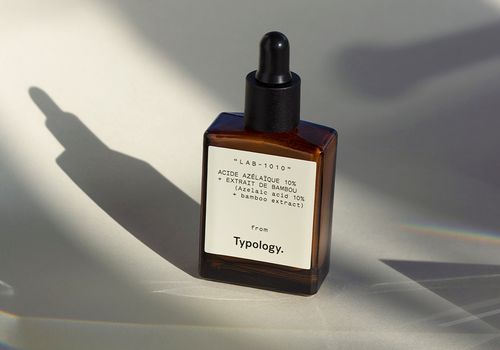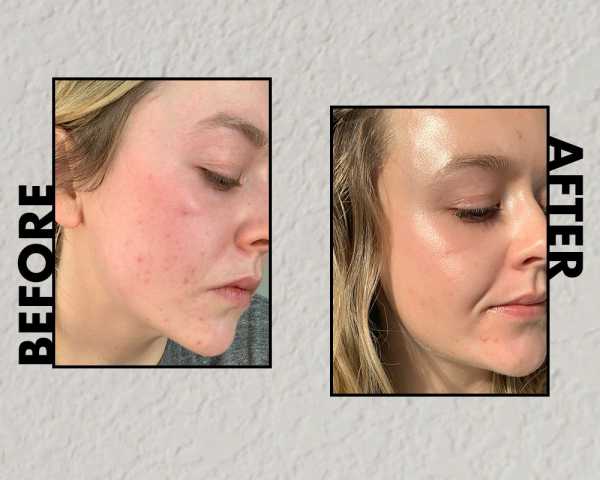
When you think of acne treatments, azelaic acid might not be the first ingredient to come to mind—or, let’s be honest, even the fifth ingredient—but it should be. Whether you use it as a cream, gel, or foam cleanser, this treatment may banish bacteria and reduce redness brought on by different skin conditions.
Azelaic acid is a favorite of dermatologists for its gentleness and versatility (it helps with way more than just acne breakouts), this skin care ingredient deserves a little more respect and recognition than it gets in the beauty world. To thoroughly explain the full range of benefits of using this overachieving skincare ingredient, we turned to the pros.
Meet the Expert
- Francesa Fusco, MD, an NYC-based dermatologist who specializes in dermatologic surgery.
- Gervaise Gerstner, MD, a board-certified dermatologist for over 17 years specializing in laser treatment, microneedling, botox, and fillers.
Keep reading to see what the experts say about azelaic acid, what makes it so good, and how you should use it.
Azelaic Acid
Type of ingredient: Acid/Exfoliant
Main benefits: Fights acne, treats rosacea, lightens dark spots, and removes dead skin cells.
Who should use it: In general, anyone with acne-prone, rosacea-prone skin, and hyperpigmentation. Fusco says azelaic acid is recommended for all skin types and is even safe for those who are pregnant.
How often can you use it: It is safe to use twice a day (morning and night) or once every other day for those with sensitive skin.
Works well with: Alpha-hydroxy acids (AHA), beta-hydroxy acid (BHA), and retinol.
Don’t use with: Azelaic acid is safe to use in conjunction with most, if not all, ingredients.
What Is Azelaic Acid?
In short, Gerstner says azelaic acid is a dicarboxylic acid that helps exfoliate the skin and is synthesized by yeast naturally—but it can be derived from several places. “Azelaic acid is produced naturally on your skin by yeast, but you can also make it in a laboratory, and it can come from grains and cereals,” Fusco says. In addition to being comedolytic (meaning it prevents comedones – blackheads) and working to exfoliate deep within the pores, Fusco says azelaic acid is also keratolytic (decreases keratin), anti-inflammatory, and has antioxidant properties. Like we said, it’s an overachiever.
Though Fusco and Gerstner recommend a prescription form of azelaic acid to their patients (either Finacea or Azelex) in a strength of 15 percent to 20 percent respectively, it's also available over the counter in a lower strength of 10 percent or less. Azelaic acid can be found in leave-on topical treatments and comes in gel, foam, and cream forms, which are designed to be used on different areas of the body. For instance, the foam version is better suited to cover a larger area like the back than a small cream or gel would be.

Benefits of Azelaic Acid for Skin
Azelaic acid is a multifunctional skincare ingredient that tackles a multitude of concerns related to breakouts and inflammation:
- Gently exfoliates: It goes deep within the pores and removes dead skin cells that cause dull skin tone and clogged pores.
- Fights acne: It has antibacterial properties, and according to Fusco, it’s reported to be bactericidal to P. acnes, which leads to acne.
- Reduces inflammation: Azelaic acid soothes irritation and helps to improve red bumps caused by inflammation.
- Evens skin tone: It inhibits tyrosinase, which is an enzyme that leads to hyperpigmentation. It’s effective on post-inflammatory hyperpigmentation from acne breakouts and can affect melasma as well.
- Treats rosacea: Azelaic acid could help with pore-clogging, inflammation, and secondary infections caused by rosacea: “It’s a less irritating option, which is why we use it for rosacea because the skin tends to be very sensitive,” Gerstner says.
- Is safe for pregnant women: Fusco says azelaic acid is one of the few treatment options for acne, rosacea, clogged pores, or pigmentation that is generally safe for pregnant women.
- Is gluten-free: Despite being wheat-derived, Fusco says most gastroenterologists agree that it likely can’t be absorbed significantly enough through your skin to trigger a gluten sensitivity or reaction.
- Could be helpful with alopecia: “There have been some reports suggesting that it could help treat alopecia or hair loss,” Fusco says. “Some doctors are having pharmacists incorporate it into their hair products because it might help to grow hair.”
Side Effects of Azelaic Acid
It is possible to experience slight irritation, such as stinging or tingling, when using azelaic acid. If the side effects get severe, including swelling of the face, difficulty swallowing or breathing, and hives, it should be brought to the attention of your doctor as it may indicate an allergy.
Overall, Fusco and Gerstner say they do not find that their patients have adverse reactions to it and that by and large, it's a mild type of acid.
How to Use It
Whether you’re using an OTC formula or a prescription, Gerstner suggests applying a thin layer of the product to clean, dry skin twice a day, morning and night. For someone with sensitive skin, she recommends using it once every other day.
For any type of azelaic acid product you use (foam, gel, or cream), apply it to your face and neck using a pea- or marble-size amount spread evenly over the area after you finished cleansing.
To help the azelaic acid absorb and perform even more effectively, Fusco recommends applying your AHA (like glycolic or lactic acid), BHA (salicylic acid), or retinol first to open up the skin and accept the azelaic acid more readily. Then, follow with a hydrating moisturizer and a sunscreen with SPF of at least 30 in the morning.
FAQ
- What is azelaic acid used for?
It's been used to treat both acne, the swelling caused by acne, and rosacea.
- Can you use azelaic acid every day?
According to our experts, it's best to incorporate azelaic acid gradually, to ensure your skin isn't too sensitive to it. If you aren't experiencing side effects, azelaic acid can generally be used daily up to two times per day (morning and evening). Use as directed by your dermatologist.
- How long does it take to see results from azelaic acid?
Research has found that a 20 percent azelaic acid cream can decrease mild to moderate acne by around 53 percent after 12 weeks.
Article Sources Byrdie takes every opportunity to use high-quality sources, including peer-reviewed studies, to support the facts within our articles. Read our editorial guidelines to learn more about how we keep our content accurate, reliable and trustworthy.
-
National Center for Biotechnology Information. PubChem compound summary for CID 2266, azelaic acid. Updated January 22, 2022.
-
Bisht A, Hemrajani C, Upadhyay N, et al. Azelaic acid and Melaleuca alternifolia essential oil co-loaded vesicular carrier for combinational therapy of acne. Ther Deliv. 2021;10.4155/tde-2021-0059. doi:10.4155/tde-2021-0059
-
Chilicka K, Rogowska AM, Szyguła R, Dzieńdziora-Urbińska I, Taradaj J. A comparison of the effectiveness of azelaic and pyruvic acid peels in the treatment of female adult acne: a randomized controlled trial. Sci Rep. 2020;10(1):12612. doi:10.1038/s41598-020-69530-w
-
Schulte BC, Wu W, Rosen T. Azelaic acid: evidence-based update on mechanism of action and clinical application. J Drugs Dermatol. 2015;14(9):964-968.
-
M, Sharad J, Kadhe G, Ahirrao P, et al. Evidence-based treatment for melasma: expert opinion and a review. Dermatol Ther (Heidelb). 2014;4(2):165-186. doi: 10.1007/s13555-014-0064-z
-
Hashim PW, Chen T, Harper JC, Kircik LH. The efficacy and safety of azelaic acid 15% foam in the treatment of facial acne vulgaris. J Drugs Dermatol. 2018;17(6):641-645.
-
Canavan TN, Chen E, Elewski BE. Optimizing non-antibiotic treatments for patients with acne: a review. Dermatol Ther (Heidelb). 2016;6(4):555-578. doi:10.1007/s13555-016-0138-1